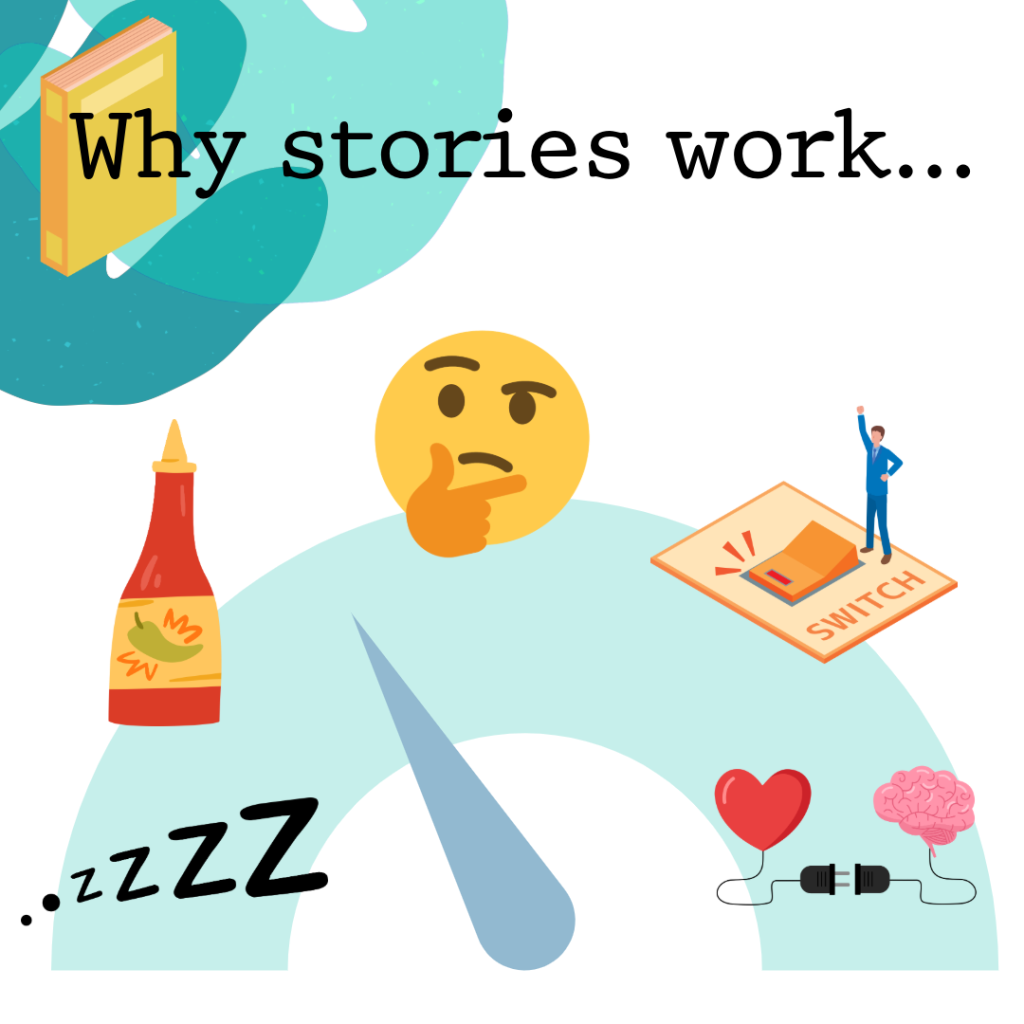1. Understand Why Stories Engage and Enhance Retention
Picture this: You’re sitting in a crowded conference room, bracing yourself for yet another mind-numbing PowerPoint presentation. Bullet points fill the screen, accompanied by dry statistics and charts so dense you consider nodding off right there in your chair. Suddenly, the presenter pauses, steps forward, and says, “Let me tell you a quick story…”
Instantly, the mood shifts. Heads lift, eyes refocus, and smartphones slide discreetly back into pockets. Why? Because we humans love stories—plain and simple. Since the dawn of civilization, storytelling has been our primary means of passing along knowledge, values, warnings, and even the latest prehistoric gossip.
But stories aren’t just entertaining—they’re scientifically proven to engage our brains, help us remember information, and motivate us to action. Storytelling is your presentation superpower, transforming forgettable presentations into memorable, impactful experiences.
Let’s dive into exactly why stories work so well, and how you can harness their incredible power to engage and persuade your audience.
Reason #1: Stories Tap into Our Natural Attention Span (No More Snoozing)
Have you ever binge-watched a favorite show for hours, completely absorbed, yet struggled to focus during a ten-minute business presentation? That’s because our brains are naturally wired to focus on stories.
Stories create a natural structure—beginning, middle, end—that our brains easily follow. Instead of fighting boredom, your brain actively anticipates what happens next, keeping you engaged effortlessly.
Real-world Example:
Without Story: “Our sales increased by 10% after we adopted a new strategy.”
With Story: “Six months ago, our sales team faced a major crisis. Profits were down, and motivation was dropping. But then, we tried something new—and within weeks, sales rose by 10%. Here’s exactly what we did…”
See the difference? One instantly draws you in, while the other leaves you yawning.
Reason #2: Stories Are Easier to Remember (Retention’s Secret Sauce)
Ever left a presentation only to realize you can’t recall any key points? Numbers and abstract ideas fade quickly—but stories stick. Why? Because stories trigger emotions, which boost memory.
Research shows that when information is presented as a narrative, audiences remember significantly more of it. Stories create mental images, activating our brain’s visual and emotional centers, making your message memorable long after your presentation ends.
Real-world Example:
Without Story: “80% of our customers report satisfaction with our product.”
With Story: “Let me tell you about Emily, a customer who struggled for months with ineffective software. Once she switched to our product, her frustration disappeared, and she told us she’s now happier and more productive. Emily’s story is one among many—80% of our customers have shared similar satisfaction.”
You’ll remember Emily’s story long after the statistic fades.
Reason #3: Stories Clarify Complex Ideas (No Confusion, Just Clarity)
Explaining complicated concepts using jargon or abstract explanations leaves your audience confused. But use a story or example, and suddenly even the toughest concepts become simple and understandable.
Stories illustrate abstract ideas, giving audiences relatable examples to grasp complicated topics.
Real-world Example:
Without Story: “Blockchain technology is a decentralized digital ledger.”
With Story: “Imagine a huge digital notebook, shared among hundreds of people. Every transaction is written in this notebook, and everyone has a copy. This means no one person can secretly change the entries, making it incredibly safe. That’s essentially what blockchain technology does.”
Simplified by storytelling—complex ideas become instantly clear.
Reason #4: Stories Inspire Action (Motivation to Move)
Information alone rarely motivates people to act. But stories showing struggles, victories, or transformations inspire audiences to respond emotionally—and emotionally engaged people take action.
Stories don’t just inform; they inspire, motivate, and persuade your audience to act.
Real-world Example:
Without Story: “Please consider donating to our literacy program.”
With Story: “Let me introduce you to Jamal. At age 10, he struggled to read, facing daily embarrassment and frustration. Our literacy program transformed Jamal’s life—today, he confidently reads above grade level. Your donation can help other kids like Jamal find confidence and success.”
Inspiring, motivating, and actionable. That’s storytelling in action.
Reason #5: Stories Connect You with Your Audience (Humanize Your Message)
We connect with people, not pie charts. When you share a real story—especially one with emotion, vulnerability, or humor—you become relatable. And relatability builds trust.
Real-World Example:
Without Story: “Our customer service team prioritizes rapid response times.”
With Story: “I’ll never forget last summer. A frantic customer called late on a Friday. Sarah, from our team, stayed late to help. She solved the issue that night—and we gained a loyal customer for life.”
That’s not just policy—that’s personality.
Quick Checklist: Why Stories Work
When preparing your presentation, ask:
✅ Does my story grab attention from the start?
✅ Will it help the audience remember my key point?
✅ Does it make a complex idea easier to understand?
✅ Am I using it to inspire action?
✅ Does it foster connection and trust?
Real-World Scenario: Storytelling in Action
Imagine presenting a new wellness initiative to your employees:
Engaging with a story:
“I want you to meet Michael, a coworker who faced burnout and stress last year. He struggled daily with fatigue, lack of motivation, and declining performance. But, everything changed once Michael joined our wellness program. He now feels energized, motivated, and productive. Michael’s story isn’t unique—it’s possible for everyone here.”
By using a story, you’ve grabbed attention, enhanced retention, clarified benefits, inspired action, and built connection.
Final Thoughts: Storytelling Matters
Great presentations aren’t just about information—they’re about connection, engagement, retention, and inspiration. Stories provide all of these effectively. By understanding and harnessing the incredible power of storytelling, your presentations transform from forgettable data dumps into engaging, persuasive, and impactful communication.
Are you ready to structure your presentations with a compelling narrative arc? Fantastic—let’s continue crafting your powerful, story-driven presentations.
